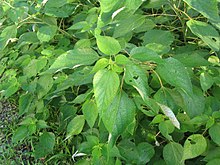Ramie
| Ramie | |
|---|---|
 |
|
| Scientific classification | |
| Kingdom: | Plantae |
| (unranked): | Angiosperms |
| (unranked): | Eudicoo = Rosids |
| Order: | Rosales |
| Family: | Urticaceae |
| Genus: | Boehmeria |
| Species: | B. nivea |
| Binomial name | |
|
Boehmeria nivea (L.) Gaudich. |
|
Ramie (/ˈreɪmi/, RAY-mee) is a flowering plant in the nettle family Urticaceae, native to eastern Asia. It is a herbaceous perennial growing to 1–2.5 m tall; the leaves are heart-shaped, 7–15 cm long and 6–12 cm broad, and white on the underside with dense small hairs—this gives it a silvery appearance; unlike stinging nettles, the hairs do not sting. The true ramie or China grass, is also called Chinese plant or white ramie.
A second type, known as green ramie or rhea, is believed to have originated in the Malay Peninsula. It has smaller leaves which are green on the underside, and it appears to be better suited to tropical conditions. The word ramie is derived from the Malay word rami.
Ramie is one of the oldest fiber crops, having been used for at least six thousand years, and is principally used for fabric production. It is a bast fiber, and the part used is the bark (phloem) of the vegetative stalks. Ramie is normally harvested two to three times a year but under good growing conditions can be harvested up to six times per year. Unlike other bast crops, ramie requires chemical processing to de-gum the fiber.
Harvesting is done just before or soon after the beginning of flowering. It is done at this time because at this stage there is a decline in plant growth and the maximum fiber content is achieved. Stems are harvested by either cutting just above the lateral roots or else bending the stem. This will enable the core to be broken and the cortex can be stripped from the plant in situ.
...
Wikipedia
